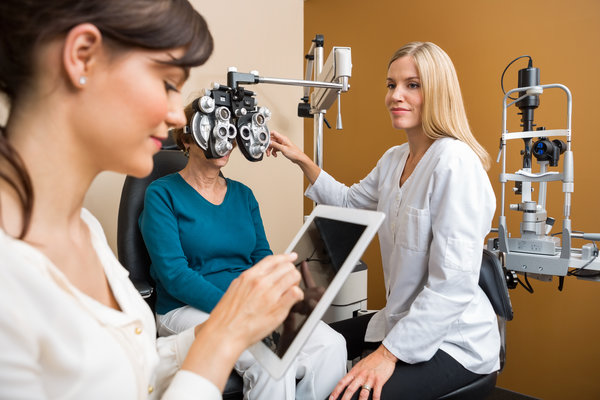Practice Management Software (PMS) streamlines the work, can create an effective interface with the patient and increases the overall productivity, enhancing the business
Two things determine what will drive your business in the future. One and probably the most important being how good is your product in the quality of the lenses, availability of the lenses, turnaround period from order to procurement and of course the range offered. The other, equally significant factor is how well you manage your clients. While the first is always high on priority, the second, is fast becoming equally important. Good service is now synonymous with fast service. Any staggered approach to professionalism will be disregarded and before you know it, the prospective business opportunity might walk off to the next and more efficient eye-care professional.
The best way to combat this is Medical Practice Management Software or PMS, a software that has been created specially
for your profession. There are several options available in the market, most of them working with the same fundamentals. It schedules appointments, maintains important fact lists, captures patient demographics, organises billing and of course generates reports. Needless to say, all big hospitals and medical outposts have adopted some version or the other of a PMS.
 But the systems they take on are hugely complicated and equipped to handle several arms of the operation, simultaneously and effortlessly. A small or middle-level eye-care professional is not really looking at such a complicated system. What you need is an effective software that is also reasonably economical. Now, a PMS can be a desktop-restricted software which is installed in your hard-drive and is operated off-line. It can also be shared with anyone you wish via an office-based network. But the one that is really easy on the nerves is the internet-based software that can be accessed from anywhere. There’s a third option as well, the client-server software, this essentially means that you lease a server specially for the purpose of a PMS and use it exclusively. This is expensive but the advantage is that multiple users can work at the same time and access it from wherever, if they are permitted to do so.
But the systems they take on are hugely complicated and equipped to handle several arms of the operation, simultaneously and effortlessly. A small or middle-level eye-care professional is not really looking at such a complicated system. What you need is an effective software that is also reasonably economical. Now, a PMS can be a desktop-restricted software which is installed in your hard-drive and is operated off-line. It can also be shared with anyone you wish via an office-based network. But the one that is really easy on the nerves is the internet-based software that can be accessed from anywhere. There’s a third option as well, the client-server software, this essentially means that you lease a server specially for the purpose of a PMS and use it exclusively. This is expensive but the advantage is that multiple users can work at the same time and access it from wherever, if they are permitted to do so.
But it is the internet based PMS that has happily overtaken the other two. Primarily because it is much cheaper than the client-server option. Of course there are spin-offs in this too and the biggest being the security risk as the programme is hosted on a secure but public server. The security can be jeopardised but with strong password application, this can be prevented. PMS application is the best way for the practitioner to keep tabs on his patients’ optical history and the diagnosis. This information can be shared with the patient, who in turn has a hands-on factsheet as a ready reckoner for himself or
any further consultations with any other practitioner.
Automation is a huge energy and time saver. Managing day to day operations through paperwork is not just exhausting but is also time consuming. Productivity is lowered drastically and overall performance is affected. A good PMS system streamlines systems and increases productivity.
 A PMS is not just about creating records and furnishing reports, it is also about analytics. When data is available on your fingertips, it is easy to analyse it in various permutations to derive desired results. It is like a noticeboard that gives you an insight as to how your business is progressing. And also acts as a guide book to how your business will progress in the future.
A PMS is not just about creating records and furnishing reports, it is also about analytics. When data is available on your fingertips, it is easy to analyse it in various permutations to derive desired results. It is like a noticeboard that gives you an insight as to how your business is progressing. And also acts as a guide book to how your business will progress in the future.
Often, a PMS is connected to an EMR (Electronic Medical Records) or EHR (Electronic Health Records). This is a comprehensive way of overseeing the entire business. While PMS mainly handles administrative and managerial data, the EMR/EHR takes care of the medical history and follow-ups. Interestingly, earlier these were separate softwares and while medical practitioners preferred the usage of both simultaneously, the integration of the two into a single unit functioning smoothly was challenging. But now, there are softwares that come pre-set with the integration, thereby making the application of the software much easier. There is another enhancement to the PMS in recent times. Since it is internet based and can be accessed anywhere, it gives the practitioner an ability to communicate with his patient directly.
Patient’s entry into the domain can be password protected, and once the patient comes online, he can execute his own set of do-ables. Like maybe post a query, reschedule an appointment or even read up on his ailment provided the eye-care practitioner has a separate section where FAQs about various ailments are answered. This area of enhanced operation in the PMS is called the ‘patient portal’ and is becoming increasingly popular.
Here is a look at some of the popular software programs used in the optical industry across the globe:
Ocuco: This software covers the complete patient journey and also handles dispensing.
Blink OMS: This software provides a comprehensive package that can help convert your entire business into a paperless one. What’s more- it would be done at a lower cost.
Crystal Practice Management : This software package includes EMR, inventory, e-Rx, billing, scheduling and much more.
Cyclops Eye Care Records: Specially created for eye-care professionals, this software is expansive and reasonable. It manages inventory handling, recall and scheduling along with amounts receivable, EMR/EHR and insurance data management.
EyeMax: This is a smart software. Not only does it handle the work of one optometrist, it is designed in such a way that it can handle several optometrists at one time. This is a perfect software for a clinic that has more than one optometrist on its panel.
What is the right software for your business?
With the market teeming with options, it is a difficult proposition to select the software that will be perfect for your business. Please remember, while the benefits of a PMS is manifold, it is vitally important to select the right kind of software that will be perfect for your organisation. So, to save time and energy later, please invest enough time on the project, weigh pros and cons and then decide upon the correct software that will aid your business perfectly.
A good PMS system that is used by the staff means that proper training has to be imparted to the staff as well! Ensure that you can spare that kind of time from the business to first learn the operating system yourself, examine and explore its various possibilities and also make time to train the staff for it. The underlining fact is that no matter how wonderful the software is, unless it is utilised properly, the end result will not be satisfactory.
PMS is the perfect tool in eliminating glitches in the operational functioning of the business. It reduces the time spent on administration functions and also helps in better patient co-ordination. It can be used as an interface with patients providing them a place to voice their anxieties and get their queries answered. A good system will reduce costs and maximise profits for the optometrist. As a bonus, it will also enrich consumer or rather patient satisfaction.












